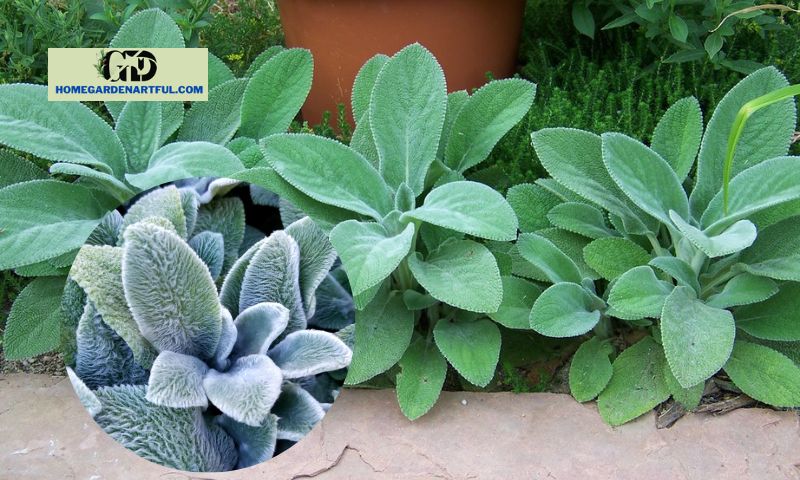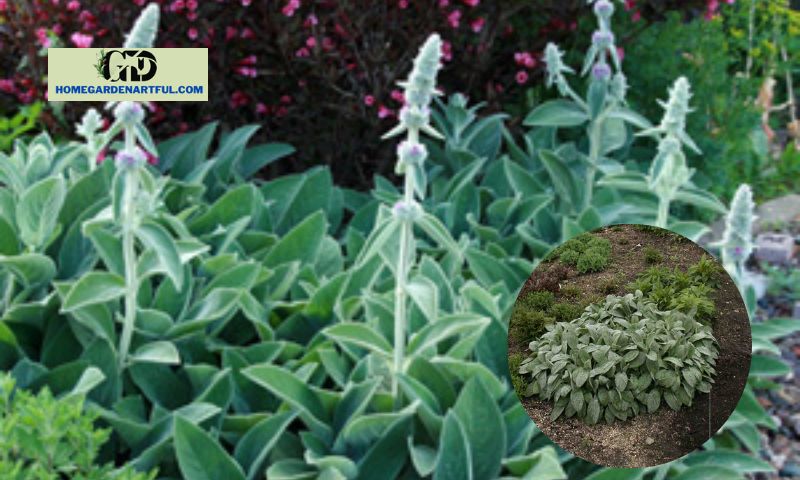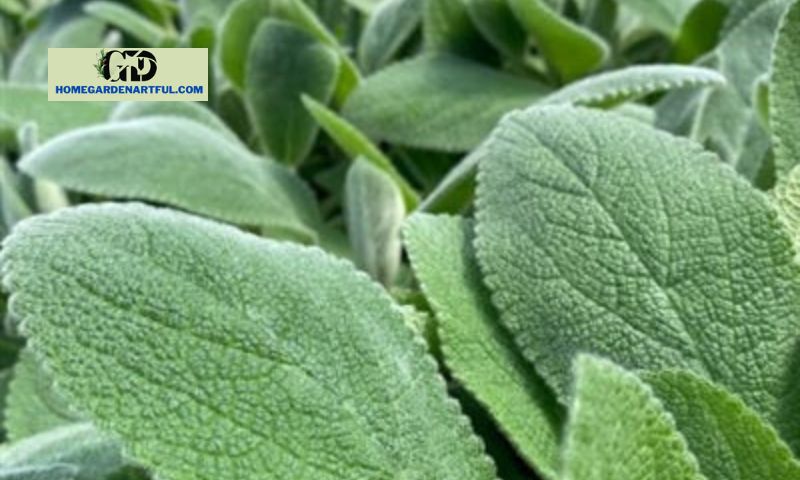On a plant with a mounded style of growth, the eye-catching big tomentose oval leaves of Helene Von Stein Lamb’s Ears emerge silver in the spring and turn grey-green over the season. Early June brings a profusion of stunning spikes of pink flowers, which look best when planted in groups and rise above the leaves. Discover at homegardenartful.com!
Uses for Helen Von Stein Lamb’s Ear

They are exceptionally drought tolerant, like many silvery plants. Lamb ears are simple plants to grow and are ideal for rock gardens or a dry area of medium soil in a garden bed. Rosettes of leaves quickly develop into a velvety mat. They were originally used as bandages and are said to be effective at easing the discomfort associated with bee stings.
In warm climates, leaves are evergreen; in colder winters, they shrink and die. Except when planted in a soggy environment, the plant survives. As springtime arrives and fresh leaves appear, remove dried-out foliage.
Helen Von Stein Lamb’s Ears are lovely to put in and individuals can walk and touch their foliage and create a charming edging for beds. Silvery leaves merge beautifully with light pink petals as well as vivid purple or pink flowers. They soften other shrubs and conceal the roses’ ugly, knobby canes.
The velvety woolly leaves of lamb’s ears seem to draw kids in most of all the kid-friendly plants in the yard. Grow it as a short, lovely border for a garden intended for kids or your own tactile sense. This perennial, with its low-maintenance silvery foliage, is essential.
How to Grow Helen Von Stein Lamb’s Ear
It is simple to grow a lamb’s ears. The following seven steps:
- Plant 4-inch pots in medium shade to full sun, 18 to 24 inches apart. As plants grow, keep them well-watered.
- Grow on compost-enriched, well-drained soil with no additional fertilizer. Rich soil does not appeal to lamb’s ears. The soil should be evenly moist to dry.
- Avoid using overhead sprinklers to water plants, and in the summer, cut away any overgrowth to avoid rot. Plants that experience humid summers will rot out from the center.
- If necessary, divide in the spring every three to four years, or just remove the foliage’s dead cores to maintain clusters.
- To assist leaves recuperate and stay soft and green, remove blooms before they set seed.
- To stop the spread of disease, remove any dried or rotten leaves.
- Diseased foliage attracts sow bugs. During the growing season, getting rid of dead leaves will help deter them.
Helen Von Stein Lamb’s Ear Treatment
The primary care requirements for cultivating lamb’s ears are as follows:
- Set these quickly spreading plants around 18 inches apart.
- Put in dry to medium-moisture soil in full sun, but be aware that in rich soil, they can be overly aggressive growers.
- Limit your watering to 1 inch each week and avoid overwatering.
- Mulch is a good way to keep leaves near to the ground as dry as possible because this plant dislikes dampness and moist soil.
Helen Von Stein Lamb’s Ear care

Light
In chilly climates, grow lamb’s ears in full sunlight. It can benefit from some shade in desert regions and hot climates. The leaves will sear in conditions of extreme heat and aridity.
Soil
This perennial does best on poor, well-drained soil with a pH that is slightly acidic. Treat it the same way you would any plant native to the Mediterranean region (many plants fit this description). Before planting, add organic matter to poor soil to promote drainage.
Water
Lamb’s ears just require a little bit of water each week—about 1 inch. Only water the soil if it seems dry. Although lamb’s ears can withstand dryness, dry spells cause them to lose some of their older leaves. The leaves will decay, and develop fungal leaf spots or powdery mildew if they become too wet, so avoid watering the tops of the plants. Particularly prone to deterioration are leaves that are close to the ground. By mulching beneath the leaves, you can aid in maintaining the foliage’s dryness.
Temperature and Humidity
Lamb’s ear thrives in all of its hardiness zones, from 4a to 9a, and can endure a wide range of temperatures. However, lamb’s ear does not appreciate humid environments since they can make them more prone to fungal leaf diseases. You normally have plenty of new plants to replace the old, rotten ones because it spreads so easily. In moderate regions, this herbaceous plant is evergreen. The leaves will wither away to the ground in harsher climates and reappear in the spring.
Fertilizer
Since lamb’s ears enjoy poor soil, most of the time you may omit giving them fertilizer. To encourage development, you can nonetheless apply a tiny coating of compost each spring.
Pruning
The lamb’s ear flower stems may appear gangly to certain producers. The plant looks neater and deters bugs when deadheaded. These pests can be avoided by removing any dead foliage or components. The plant will start to die back toward the conclusion of the growing season in late fall. To reach the soil level, remove the dead vegetation. In the spring, before new growth appears, you can remove the dead leaves if you don’t do it in the fall.
Look at the plant’s origin point in the middle of it expands and you desire to keep the clumping growths. The fact that the center and those roots are likely dead is shown by the lamb’s ears spreading away from their central location. Get rid of the dead centers. As the plant grows, more roots are formed.
Developing Helen Von Stein Lamb’s Ear

If you want to start a new Helen Von Stein Lamb’s Ear patch, either dig up more recent plants that organically self-seeded and multiplied on their own, or divide mature patches in the spring. These plants may easily be divided, and every two to three years will keep them looking good and maintaining their health.
Flowering kinds could require division more frequently than non-flowering varieties. When you have a plant that is widely spreading with a dead center, that is a visual indicator that you should divide. The spreading stems of the plant will take root anywhere they come into touch with the soil. The steps for cutting a lamb’s ear are as follows:
- You’ll need a new growing medium (or container), drainage-friendly soil, and gardening gloves.
- You can pry up the cluster of lamb’s ears with the aid of a two-tined hand pitchfork if the roots are tightly packed and resist being moved.
- Pull the clump up gradually. Remove the roots and decayed, dead sections by hand.
- The cluster should be divided into parts. Healthy fibrous roots should be present in every region.
- Plant each component at a minimum distance of 18 inches.
Growing Helen Von Stein Lamb’s Ear From Seeds
The best time to start seeds inside is in the late winter, eight to ten weeks before the last frost, If the Helen Von Stein Lamb’s Ear has flowered, you have harvested the seeds, or you have access to lamb’s ear seeds. Follow these simple steps:
- Spritz some high-quality seed-starting soil.
- Without covering, press the seed firmly into the ground. Light is required for the seed to sprout.
- Throughout the germination process, keep the soil damp.
- Once the risk of frost has passed, you can also plant seeds outside.
- The germination period of seeds is approximately 30 days.
Potting and Repotting Lamb’s Ear
Although lamb’s ear is not often kept in pots, it is occasionally used as a filler plant in big container gardens. Only once a week or so does it require water. If you keep it with other plants, be sure they require equivalent amounts of watering. Use planters made of clay or terra cotta that have enough drainage holes to assist in avoiding overwatering problems.
Overwintering
The plant is resilient to cold. It will die back and not look attractive, but it typically grows back in the spring. The only unanticipated events are root rot, bugs, or further diseases that could spread if you let the dead leaves decompose. To maintain its health and growth patterns, shear the entire plant at the soil line at the conclusion of the growing season. Plants are more susceptible to pests and disease when dead leaves and growth are left on the plant.
Common Diseases
Because of its hairy leaves, a Helen Von Stein Lamb’s Ear does not readily attract pests. However, due to its susceptibility to humidity and poorly draining soil, it is vulnerable to fungal disease. Even if the soil is well-draining, it can still develop rot and leaf spots during the humid summer months. Eliminate and discard the impacted plants.
Sometimes, diseased foliage will draw sowbugs, a type of land crustacean that feeds on the fungi and bacteria on decaying and dead plant material rather than being an insect. Spread diatomaceous earth, a desiccant that dries up and kills sowbugs, on top of the soil surrounding the plants to get rid of them.
FAQ
What distinguishes mullein from lamb’s ear?
Plants with velvety, fuzzy leaves include mullein (Verbascum sp.) and lamb’s ear (Stachys byzantine). Despite having a similar appearance, they do not belong to the same plant families. They have varied growth habits and slightly varying environmental requirements. Lamb’s ear spreads similarly, although mullein does not, and is frequently a much larger specimen. The leaves of lamb’s ear are often softer than those of mullein.
What is a substitute for lamb’s ears?
Consider silver sage if you don’t want your lamb’s ear to take over a space but you prefer the soft, silvery foliage. Lamb’s ears can be successfully substituted with silver sage. It has large, imposing, hairy leaves that are velvety and silvery. Silver sage is more heat- and humidity-tolerant, and the blossoms are more impressive than lamb’s ear.
Can Helen Von Stein Lamb’s Ear grow indoors?
Helen Von Stein Lamb’s Ears can be kept as a houseplant, although they need a lot of light. Put it in a south-facing window with grow lights or at least eight hours of direct light. To prevent wetting the leaves, use less water and water the soil from the bottom up.


